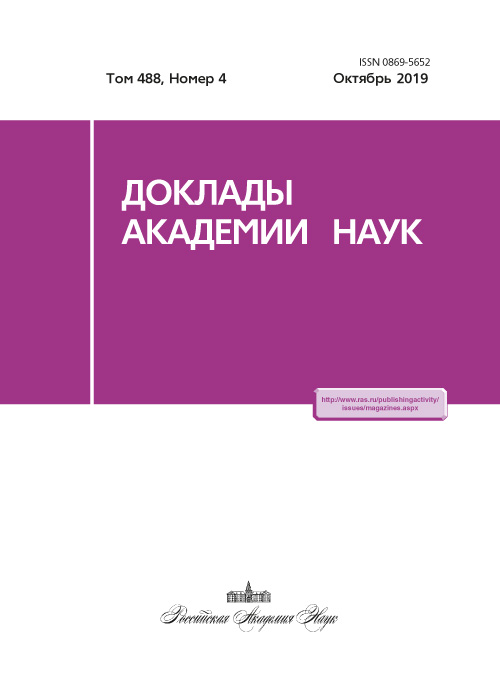Effect of Fe nanopowder sample density on ignition parameters at heating in the air
- Authors: Alymov M.I.1, Vadchenko S.G.1, Suvorova E.V.1, Zelensky V.A.2, Ankudinov A.B.2
-
Affiliations:
- Merzhanov Institute of Structural Macrokinetics and Materials Science
- Baikov Institute of Metallurgy and Materials Science of the Russian Academy of Sciences
- Issue: Vol 488, No 4 (2019)
- Pages: 386-390
- Section: Physical chemistry
- URL: https://journals.eco-vector.com/0869-5652/article/view/17679
- DOI: https://doi.org/10.31857/S0869-56524884386-390
- ID: 17679
Cite item
Abstract
Ignition of Fe nanopowders of bulk density and its samples compacted to relative density of 0,3-0,5 was studied while they were heated in the air. The ignition temperature of the compacted samples does not depend on the heating rate and comprises 100-115 °C. The oxidation process includes the stages of inert heating, ignition, surface and filtration modes of the reaction and afterburning. The time of the active stages, i.e. ignition and filtration mode, depends on the sample density at the same heating terms. It allows one to develop storage methods of Fe nanopowders as compacts.
Keywords
About the authors
M. I. Alymov
Merzhanov Institute of Structural Macrokinetics and Materials Science
Author for correspondence.
Email: alymov@ism.ac.ru
Corresponding Member of the Russian Academy of Sciences
Russian Federation, 142432, Moscow Region, Chernogolovka, Academician Osypian street, 8S. G. Vadchenko
Merzhanov Institute of Structural Macrokinetics and Materials Science
Email: alymov@ism.ac.ru
Russian Federation, 142432, Moscow Region, Chernogolovka, Academician Osypian street, 8
E. V. Suvorova
Merzhanov Institute of Structural Macrokinetics and Materials Science
Email: alymov@ism.ac.ru
Russian Federation, 142432, Moscow Region, Chernogolovka, Academician Osypian street, 8
V. A. Zelensky
Baikov Institute of Metallurgy and Materials Science of the Russian Academy of Sciences
Email: alymov@ism.ac.ru
Russian Federation, 49, Leninskii Prospect, Moscow, 119334
A. B. Ankudinov
Baikov Institute of Metallurgy and Materials Science of the Russian Academy of Sciences
Email: alymov@ism.ac.ru
Russian Federation, 49, Leninskii Prospect, Moscow, 119334
References
- Bouillard J., Vignes A., Dufaud O., Perrin L., Thomas D. Ignition and Explosion Risks of Nanopowders // France J. Hazardous Materials. 2010. V. 181. № 1/3. P. 873.
- Бернер М.К., Зарко В.Е., Талавар М.Б. Наночастицы энергетических материалов: способы получения и свойства (обзор) // Физика горения и взрыва. 2013. T. 49. № 6. С. 3-30.
- Алымов М.И., Рубцов Н.М., Сеплярский Б.С., Зеленский В.A., Анкудинов А.Б. Исследование зависимости временных характеристик воспламенения и горения нанопорошков железа на воздухе от длительности пассивации после синтеза // Российские нанотехнологии. 2017. T. 12. № 5/6. C. 18-21.
- Alymov M.I., Rubtsov N.M., Seplyarsky B.S., Zelensky V.A., Ankudinov A.B. Passivation of Iron Nanoparticles at Subzero Temperatures // Mendeleev Commun. 2016. V. 26. P. 452.
- Alymov M.I., Rubtsov N.M., Seplyarsky B.S., Zelensky V.A., Ankudinov A.B. Features of Combustion and Passivation of Nickel Nanoparticles // Mendeleev Commun. 2016. V. 26. P. 549.
- Зеленский В.А., Алымов М.И., Анкудинов А.Б., Трегубова И.В. Низкотемпературное водородное восстановление медных порошков // Перспективные материалы. 2009. № 6. C. 83.
- Лернер М.И., Сваровская Н.В., Псахье С.Г., Бакина О.В. Технология получения, характеристики и некоторые области применения электровзрывных нанопорошков металлов // Российские нанотехнологии. 2009. T. 4. № 11/12. C. 56-68.
Supplementary files







